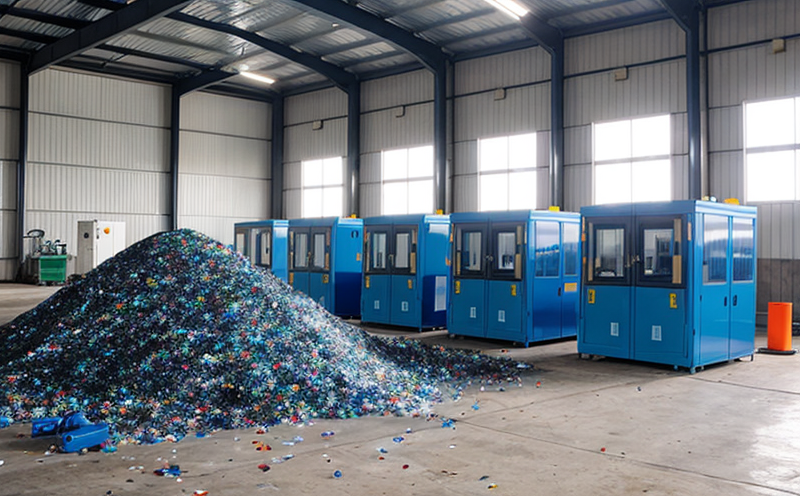ISO 18264 Plastics Chemical Recycling Potential Assessment
The ISO 18264 standard provides a framework to assess the chemical recycling potential of plastics. This method is critical for waste management and recycling testing as it helps identify whether a plastic can be effectively recycled through chemical means, thereby minimizing waste and promoting sustainability.
Chemical recycling, also known as advanced recycling, differs from mechanical recycling by breaking down plastics into their base chemicals or monomers to produce new polymers. This process is particularly beneficial for mixed polymer streams or contaminated materials that are challenging to recycle mechanically due to impurities such as additives, fillers, and pigments.
The ISO 18264 standard outlines a comprehensive approach to evaluating the feasibility of chemical recycling by assessing several key parameters:
- Thermal stability of the plastic
- Purity of the feedstock obtained from chemical processes
- Inhibition of undesirable side reactions during processing
- Economic viability and energy efficiency of the process
- Environmental impact assessment, including greenhouse gas emissions
The first step in this assessment is to collect samples representing the plastic material you wish to evaluate. These samples should be representative of the batch or stream being considered for chemical recycling. Proper sample preparation includes cleaning and drying the samples to eliminate any contaminants that could affect test results.
Once the samples are prepared, they undergo a series of tests designed to measure their chemical properties:
- Determination of the molecular weight distribution using gel permeation chromatography (GPC)
- Analysis of thermal stability through thermogravimetric analysis (TGA) and differential scanning calorimetry (DSC)
- Evaluation of the presence of additives, fillers, or pigments that could interfere with chemical recycling
- Determination of monomer purity if possible by gas chromatography-mass spectrometry (GC-MS)
The results from these tests are then used to determine whether the plastic is suitable for chemical recycling. The standard provides criteria for acceptable levels of impurities, thermal stability, and other factors that will influence the success of a chemical recycling process.
Chemical recycling is particularly advantageous in scenarios where mechanical recycling fails due to the presence of contaminants or when dealing with mixed polymer streams. For instance, end-of-life textiles, electronics waste, and multi-layer packaging can be effectively recycled through this method. By assessing these materials according to ISO 18264, businesses can make informed decisions about which materials are best suited for chemical recycling.
Understanding the potential of plastics for chemical recycling is crucial for companies involved in sustainable waste management practices. This knowledge allows them to optimize their processes and comply with regulatory requirements while contributing positively to environmental sustainability goals.
Benefits
The implementation of ISO 18264 Plastics Chemical Recycling Potential Assessment offers numerous benefits that align with broader sustainability initiatives:
- Eco-Friendly Solutions: By enabling the recycling of difficult-to-process plastics, this assessment supports a circular economy, reducing landfill waste and decreasing reliance on virgin materials.
- Cost Efficiency: Reduces costs associated with disposal by converting waste into valuable resources such as raw materials for new products.
- Innovation Opportunities: Encourages innovation in recycling technologies and processes, leading to the development of more efficient and sustainable methods.
- Regulatory Compliance: Ensures that businesses meet environmental standards set by various international bodies, including ISO and European Union directives.
- Brand Reputation: Enhances corporate image by demonstrating a commitment to environmental responsibility and sustainability.
- Resource Optimization: Maximizes the use of existing resources through effective recycling practices, conserving natural resources.
The successful implementation of this assessment can lead to significant improvements in waste management strategies across industries. It empowers organizations to make data-driven decisions regarding which materials are most suitable for chemical recycling, ultimately contributing to a more sustainable future.
Quality and Reliability Assurance
The ISO 18264 standard ensures the quality and reliability of assessments by providing clear guidelines and criteria that must be adhered to during testing. This includes precise methods for sample preparation, standardized procedures for each test, and stringent acceptance criteria.
To ensure consistent and reliable results, laboratories performing these assessments follow rigorous protocols laid out in the ISO 18264 standard. These protocols cover everything from initial sample collection and handling to the execution of specific tests like GPC, TGA, DSC, GC-MS, and others mentioned earlier.
The use of advanced analytical instrumentation plays a crucial role in achieving accurate results according to ISO 18264. Laboratories equipped with state-of-the-art equipment such as high-performance liquid chromatographs (HPLC), Fourier transform infrared spectrometers (FTIR), and mass spectrometers ensure precise measurements.
Inter-laboratory comparisons are also conducted regularly to maintain the accuracy and consistency of results across different facilities. This process involves sharing test data and protocols among participating laboratories, allowing for continuous improvement in analytical techniques and methodologies.
By adhering strictly to ISO 18264 standards, laboratories can provide reliable assessments that meet both internal quality control requirements and external regulatory expectations. The standard's emphasis on reproducibility ensures that findings are robust and trustworthy, fostering confidence within the industry and among stakeholders.
Competitive Advantage and Market Impact
The adoption of ISO 18264 Plastics Chemical Recycling Potential Assessment offers significant competitive advantages and impacts market dynamics positively:
- Innovation Leadership: Companies leading the way in implementing this assessment can position themselves as industry leaders, attracting investors and strategic partners.
- Customer Satisfaction: Meeting or exceeding customer expectations by offering sustainable solutions enhances brand loyalty and customer satisfaction.
- Premium Pricing: Products derived from chemical recycling may command higher prices due to their perceived environmental benefits, providing a competitive edge in the marketplace.
- Better Resource Management: Efficiently managing resources through effective waste management practices can lead to cost savings and operational efficiencies, improving overall profitability.
- Market Expansion: Demonstrating expertise in this area allows companies to expand into new markets that prioritize sustainability and environmental responsibility.
The market for sustainable products is growing rapidly as consumers become more environmentally conscious. By embracing ISO 18264 Plastics Chemical Recycling Potential Assessment, businesses not only meet current demand but also anticipate future trends. This proactive approach ensures long-term success in the competitive global market.





